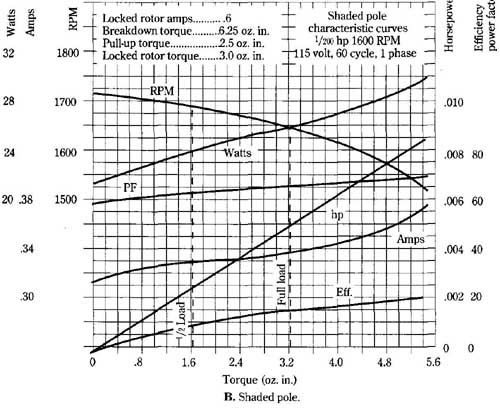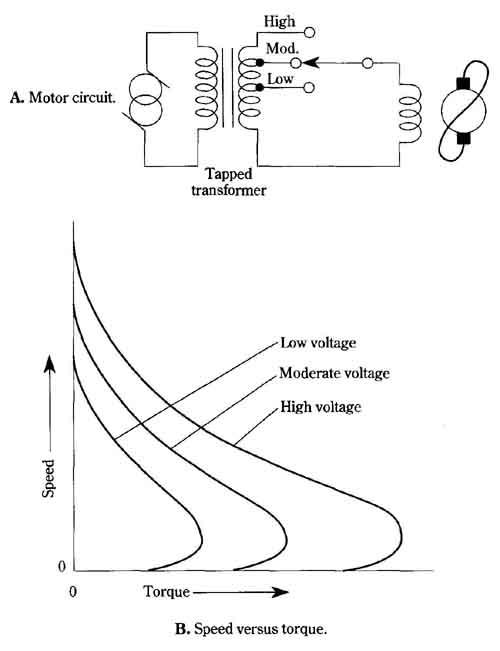AMAZON multi-meters discounts AMAZON oscilloscope discounts
. The discussion of the AC series motor, or universal motor, will serve to introduce the basic principle underlying the repulsion motor. The use of resistance inserted be tween the armature conductors and commutator segments was mentioned. Such resistance limits the short-circuit current that flows between adjacent commutator segments that happen to be located under the brushes during a start from standstill.


FIG. 2 The AC characteristics of a small universal motor.
The source of this short circuit current is unintentional transformer action between the field windings and the armature conductors (this did not exist in the stationary DC series motor). It contributes nothing to motor action but is very hard on the brushes and the commutator. In the running motor, the same action continues to take place, but its effects become less harmful because the heating is then distributed over all of the commutator segments. This undesirable effect stems from trans former action.
A clearer case of transformer action accounted for the effect of inductively coupled compensating and interpole windings. Here, the effect was achieved by intent.
It would be only natural now to ponder the feasibility of coupling AC power into the rotating armature via electromagnetic induction rather than via the conductive connection to the field windings used in series motors. True enough, it has just been stated that this already occurs, causing heat dissipation. However, it’s desirable to make the induced current somehow develop torque, rather than primarily heat. You can “invent” this motor by the simple expedient of short-circuiting the two brushes and rotating the brush axis so that it coincides neither with the geometric-neutral axis nor with the axis of the poles. And the conductive connection between series field and armature is eliminated.
The repulsion motor thereby created retains the basic speed and torque behavior of the AC series, or universal, motor. It has two important advantages, however. It can be designed so that the objectionable dissipative transformer current is virtually neutralized at a certain speed, thereby providing relatively clean commutation. In practice, good commutation is obtained over a usable speed range. And, because the armature is not connected to the power line, it can be designed for a convenient low voltage. This greatly reduces insulation problems in the armature and in the brush assembly. At higher speeds, the dissipative transformer currents provide a braking effect, which prevents racing at low speeds. FIG. 3 shows the basic relationships pertaining to the repulsion motor.
If it has not previously been encountered, the shorted armature depicted in these diagrams might be startling. The symbolization is somewhat modified from that used before, in order to emphasize that the field poles are alternately north and south—the phase dots reveal that the field windings are connected so that when one pole is north, the other pole is south. And, unlike the armature in AC series and universal motors, the armature in repulsion motors is conductively isolated from both the field and the power line.
In the situation shown in FIG. 3A, the short-circuit brushes are analogous to a short across the detector of a balanced Wheatstone bridge. That is, the voltages induced in the two sectors of the armature winding are equal and are polarized so that there is no net current flow through the shorting connection. This is tantamount to saying that no current flows in the armature conductors. Consequently, no torque is developed.
In FIG. 3B, the brush axis coincides with the axis of the field poles. If the necessary modifications to accomplish this were made, considerable humming, vibration, and heat would be produced. However, no net torque would be forthcoming because now the two sectors of the armature winding carry equal, but opposite, cur rents. The resulting torques, though strong, cause rotation with equal force in opposite directions.
---

FIG. 3 Basic relationships in the repulsion motor.
A. Brush axis at geometric neutral. B. Brush axis coincides with pole axis. C. Brush axis set at inter mediate angle. D. Brush axis 90-degr. from position (C). E. Permanent-magnet equivalent of magnetic conditions depicted in (D). F. Condition depicted in (E) — one -half cycle later.
---
The in-between brush positions shown in Figs. 3-3C and D enable motor operation to be achieved because of the unequal currents that are developed in the two sectors of the shorted armature. Torque in one direction then predominates, and the motor operates and carries a load. The application of a mechanical load slows down the speed, enabling the current difference between the armature segments to increase because of a decrease in generator action. Accordingly, a greater electromagnetic torque is developed (the interaction between transformer and generator action is similar to that between counter EMF and applied armature voltage in a DC ma chine). Notice that the direction of rotation is the same as the direction of brush shift from geometric neutral.
In Figs. 3E and F the permanent-magnet equivalents of the situation in FIG. 3D are shown for both halves of the AC cycle. In the rotating motor, successive armature loops occupy an angular position such that their magnetic field simulates that of the permanent-magnet rotor. Whereas the magnet rotor can experience only a transitory displacement from its illustrated position, the motor armature rotates continuously because a new “magnet” is introduced every time appropriate armature loops undergo shorting action by the brushes. The speed-torque characteristics of the repulsion motor are shown in FIG. 4.

FIG. 4 General speed/torque characteristics of the repulsion motor.
A. Motor circuit. B. Speed versus torque.
===